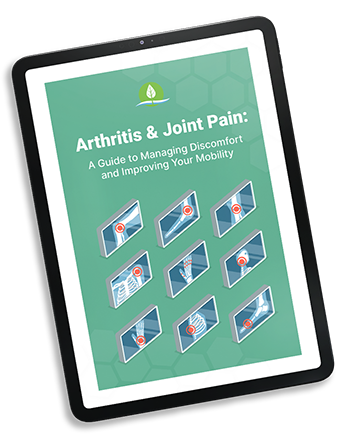Arthritis means inflammation (-itis) of the joints (arthro-).
Most people know arthritis as painful, stiff, and warm joints that impair your ability to move around.
But do you know “arthritis” actually describes more than 100 conditions that affect the joints and tissues?
The most common types of arthritis include osteoarthritis, rheumatoid arthritis, fibromyalgia, gout, and lupus.
Every year in the United States, 58.5 million adults (22.7%) are informed by their doctors that they have arthritis.
Plus, the number of people with arthritis is increasing at a rocket speed, with approximately 10 million within the recent decade (2010 to 2020).
By 2040, it is estimated that 78 million (26%) Americans over 18 years old will have medically-diagnosed arthritis, as reported by the CDC.
Now, do you want to be one of the remaining lucky 74% of people? Read further to learn how to prevent arthritis.
Get Your FREE Arthritis Guide
- Learn how to naturally improve your arthritis symptoms
- Dietary recommendations, exercise guides, supplements, and lifestyle changes
- Developed exclusively by our medical doctor
How to prevent arthritis
As mentioned at the start, there are many kinds of arthritis, and unfortunately, not all arthritis can be prevented.
But some risk factors of arthritis have been identified and proven preventable. For modifiable risk factors, scientists have found 3 crucial aspects of arthritis prevention: weight control, joint injury prevention, and muscle function preservation.
1) Manage your weight
Being overweight or obese is a well-known risk factor for arthritis. Studies conducted among the US population found that obese people are at a 30% higher risk of developing symptomatic arthritis.
Besides, the impact of obesity on arthritis risk lasts for a long term. For example, a study on young students revealed that every 8 kg weight gain leads to a 70% increase in the risk of arthritis 30 years later.
Meanwhile, 5 kg weight loss reduced the risk of arthritis by more than 50 % over 10 years, as reported by another longitudinal cohort study.
Here are some proven practical ways to cut down and maintain weight at a healthy range:
Adjust your diet
Dietary intervention is the cornerstone of weight management. Many guidelines recommend adhering to a low-calorie diet and creating an energy deficit of 500 to 750 calories daily to reduce weight.
These behaviors reduce your risk of obesity and benefit your cardiovascular health, according to the American Heart Association.
Exercise regularly
If you are a healthy adult, try to do at least 150 minutes of moderate-intensity aerobic exercise (cycling, fast walking, dancing, playing basketball, etc.) every week.
On the other hand, the elderly population should aim for light daily exercise. In simple words, keep your body moving instead of sitting or lying down.
Examples are standing up instead of long sitting, walking around your home, cleaning and dusting, and making the bed.
If you have other medical conditions or have not exercised for some time, talk to your doctor first before starting your exercise plan.
Consider medications
Your doctor may prescribe you medications to treat your obesity. However, keep in mind that medication is just a supportive measure to complement the main therapy, which is lifestyle modification (diet and exercise).
Consider weight loss surgery
Your doctor may recommend bariatric surgery when all other interventions fail. This surgical option is usually the last choice and only for people in the morbidly obese category (body mass index above 40).
2) Avoid joint injury
Data shows hip, knee, and ankle injuries accounted for 12% of arthritis cases. Among all types of injuries, the anterior cruciate ligament (ACL) tear is most closely linked to arthritis.
About half of the individuals with ACL tears develop arthritis in 10 to 15 years, regardless of whether reconstruction surgery has been made.
Joint injury prevention is a lifelong mission. Since knee injuries often occur in young adults, prevention should start early.
Here are some notes for you to protect yourself from joint injury as prevention for arthritis:
Proper warm-up and cool-down during workouts
Warming up before exercise activates your muscle, improves your body’s flexibility, and prevent soft tissue injuries such as ACL tears.
A warm-up takes around 10 minutes and usually involves light aerobic activity or stretching.
Examples are fast-paced walking and side-stepping, walking up and down stairs, jogging on the spot, arm swings, lunges, and squats.
After exercise, gently stretch all your muscles for 10 to 15 seconds to restore your muscle strength.
Wear knee braces and proper shoes
These types of equipment are essential if you are an athlete or actively involved in sports.
By distributing pressure to different structures of the knee, braces provide support and reduce the wear and tear of the knee. It also helps alleviate pain for those who already have arthritis.
There are many types of knee braces and sports shoes in the market. If you are unsure which one suits you best, talk to your physical therapist, podiatrist, and orthopedic or sports medicine doctor.
Fall prevention among older adults
Falls can cause serious complications, especially in older adults. In the United States, there is a senior fall every second, and every 20 minutes, a senior die from a fall.
Many more are injured, speeding up the development of arthritis. To understand how you can prevent fall injuries, follow the CDC’s STEADI (Stopping Elderly Accidents, Deaths & Injuries) initiative, which comprises 4 key strategies:
- Have your healthcare provider review your medications
- Exercise to improve your balance and strength
- Regular eyes and feet check-ups
- Create a low fall risk home environment.

3) Build optimal muscle function
A strong and balanced muscle absorbs pressure exerted on the joints, thus protecting the joints from excessive stress.
Therefore, building your muscle strength is an excellent strategy in arthritis prevention.
Here are 2 main types of exercises that help build optimal muscle:
Neuromuscular exercise
Neuromuscular exercises target our sensorimotor (nerve and muscle function) system. These exercises improve our sensorimotor control and joint stability.
In addition, it also helps to prevent the worsening of arthritis symptoms, as reported by multiple research studies.
In brief, neuromuscular exercise comprises 11 exercises that last about 60 minutes per training session.
Talk to your physical therapist to learn how you can partake in neuromuscular exercise.
Strength training exercise
A strength training exercise is any activity that requires your muscles to work harder than usual and usually involves workouts against resistance.
It boosts your muscles’ strength, size, power, and endurance. In the scope of arthritis prevention, lower limb exercises are of utmost importance.
Examples of exercises include sit-to-stand, mini-squats, calf raises, sideways leg lifts, and leg extensions.
Conclusion
We may not be able to prevent arthritis altogether, but we can tackle its modifiable risk factors to minimize the risk. Start your arthritis prevention plan when you are still young, as prevention is always better than cure.
Explore More








